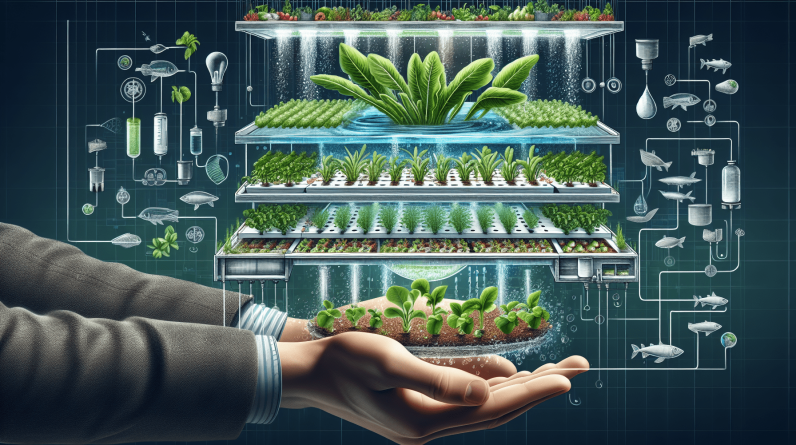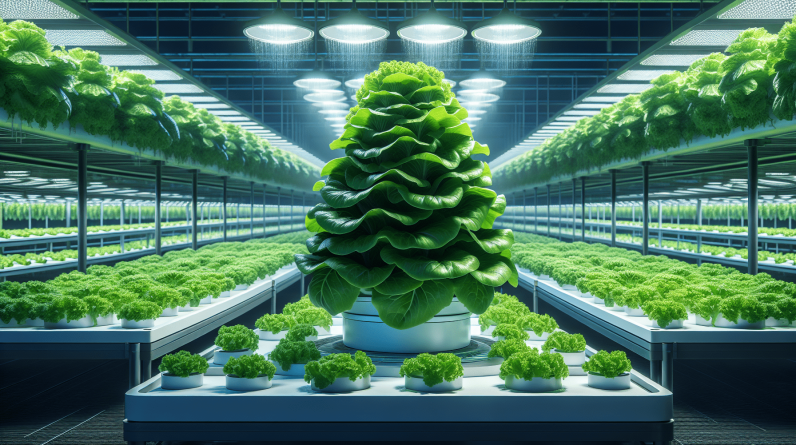
Have you ever wondered why hydroponic lettuce is becoming increasingly popular for urban gardens?
Understanding Hydroponic Growing Systems
Hydroponic growing systems are revolutionizing the way we grow plants, especially in urban settings where space is limited. By providing essential nutrients directly to the roots in a water-based solution, hydroponics eliminates the need for soil, allowing plants to grow faster and produce more. This method not only conserves water but also enables year-round cultivation, making it an ideal choice for urban gardeners looking to maximize their harvests.
Benefits of Hydroponic Growing Systems
One of the primary benefits of hydroponic growing systems is their ability to save water. Traditional soil gardening can be water-intensive, but hydroponics uses up to 90% less water, making it a sustainable option for urban gardeners concerned about resource conservation. Additionally, hydroponic systems reduce the risk of soil-borne diseases and pests, resulting in healthier plants that require fewer chemical inputs. By providing a controlled environment for plant growth, hydroponic systems offer a more efficient and effective way to cultivate crops in urban gardens.

The Advantages of Hydroponic Lettuce
When it comes to urban gardening, hydroponic lettuce stands out as an excellent choice for several reasons. Let’s explore why hydroponic lettuce is the best option for urban gardens and how it can benefit both the gardener and the environment.
Faster Growth and Higher Yields
Hydroponic lettuce grows faster and produces higher yields compared to lettuce grown in soil. By delivering nutrients directly to the roots, hydroponic systems enable plants to absorb essential elements more efficiently, promoting rapid growth and robust development. This means that urban gardeners can enjoy a continuous harvest of fresh, crisp lettuce throughout the growing season, without the limitations of traditional soil gardening.
Space-Efficient Cultivation
Urban gardens often face space constraints, making it challenging to grow a variety of crops. Hydroponic lettuce offers a space-efficient solution, as it can be cultivated vertically or in compact systems, maximizing the use of available space. Whether you have a small balcony or a rooftop garden, hydroponic lettuce allows you to grow fresh greens without the need for extensive acreage, making it an ideal option for urban dwellers with limited gardening space.
Resource Conservation
In addition to saving water, hydroponic lettuce promotes resource conservation by reducing the need for soil and chemical inputs. Without the use of traditional planting mediums, hydroponic systems minimize waste and environmental impact, making them a sustainable choice for urban gardeners looking to cultivate crops in an eco-friendly manner. By growing lettuce hydroponically, you can enjoy fresh, nutrient-rich produce while minimizing your carbon footprint and contributing to a more sustainable food system.

Types of Hydroponic Systems for Lettuce Cultivation
There are several types of hydroponic systems that are well-suited for growing lettuce in urban gardens. Each system has its unique characteristics and advantages, catering to different preferences and gardening environments. Let’s explore some popular hydroponic systems for cultivating lettuce and how they can benefit your urban garden.
Nutrient Film Technique (NFT) System
The Nutrient Film Technique (NFT) system is a popular choice for growing lettuce hydroponically due to its simplicity and efficiency. In an NFT system, nutrient-rich water is continuously circulated through a shallow channel, allowing the plant roots to absorb essential elements while maintaining proper hydration. This system is ideal for lettuce cultivation, as it promotes healthy root development and prevents waterlogging, ensuring optimal growing conditions for your greens.
Deep Water Culture (DWC) System
The Deep Water Culture (DWC) system is another effective method for growing lettuce hydroponically, especially in urban gardens with limited space. In a DWC system, plants are suspended in a reservoir filled with oxygenated nutrient solution, allowing the roots to grow freely and absorb nutrients efficiently. This system is easy to set up and maintain, making it a convenient option for urban gardeners looking to grow lettuce year-round without the need for soil.
Tower Garden System
The Tower Garden system offers a vertical growing solution for urban gardeners interested in cultivating lettuce hydroponically. By stacking multiple growing trays on a vertical tower, this system maximizes space utilization while providing a nutrient-rich environment for plant growth. Tower gardens are well-suited for growing lettuce and other leafy greens, offering a compact and efficient way to produce fresh produce in urban settings. With a Tower Garden system, you can enjoy a bountiful harvest of lettuce without taking up valuable horizontal space in your garden.

Tips for Growing Hydroponic Lettuce Successfully
Growing hydroponic lettuce in your urban garden requires careful planning and maintenance to ensure a successful harvest. By following these tips and best practices, you can cultivate healthy, vibrant lettuce plants using a hydroponic system and enjoy a continuous supply of fresh greens throughout the growing season.
Choose the Right Lettuce Varieties
When selecting lettuce varieties for hydroponic cultivation, choose varieties that are well-suited for indoor growing and have a quick maturity time. Leaf lettuce varieties such as red oak leaf, green leaf, and butterhead lettuce are excellent choices for hydroponic systems, as they thrive in controlled environments and produce tender, flavorful leaves. By selecting the right lettuce varieties for your hydroponic garden, you can ensure a successful harvest and enjoy a variety of fresh greens year-round.
Maintain Proper Nutrient Levels
To promote healthy growth and development, it is essential to maintain proper nutrient levels in your hydroponic system. Monitor the nutrient solution regularly, ensuring that it contains the necessary elements for optimal plant growth. Adjust the nutrient levels as needed to prevent deficiencies or imbalances that can affect the health and productivity of your lettuce plants. By providing the right nutrients at the right time, you can support robust growth and abundant yields of fresh, flavorful lettuce in your urban garden.
Monitor pH and Temperature Levels
In addition to nutrient levels, it is crucial to monitor the pH and temperature of the nutrient solution in your hydroponic system. Lettuce plants prefer slightly acidic conditions with a pH range of 5.5 to 6.5, and maintaining the proper pH level is essential for nutrient absorption and root health. Similarly, maintaining the temperature of the nutrient solution within the optimal range of 65 to 75 degrees Fahrenheit is crucial for promoting healthy growth and preventing stress-related issues in your lettuce plants. By monitoring pH and temperature levels regularly, you can create an optimal growing environment for your hydroponic lettuce and ensure a successful harvest.
Provide Sufficient Light and Air Circulation
Lettuce plants require adequate light and air circulation to thrive in a hydroponic system. Ensure that your hydroponic garden receives ample sunlight or artificial light to promote photosynthesis and leaf development. Position grow lights or natural light sources strategically to provide consistent lighting throughout the day and maintain the health and vitality of your lettuce plants. Additionally, ensure proper air circulation around your plants by using fans or airflow systems to prevent mold, mildew, and other issues that can arise in humid environments. By providing sufficient light and air circulation, you can create an optimal growing environment for your hydroponic lettuce and enjoy a bountiful harvest of fresh, delicious greens.

Harvesting and Enjoying Hydroponic Lettuce
Once your hydroponic lettuce plants have reached maturity, it’s time to harvest and enjoy the fruits of your labor. Harvesting lettuce is a straightforward process that involves cutting the leaves close to the base of the plant to encourage regrowth and continued production. By following these tips for harvesting and storing hydroponic lettuce, you can enjoy a continuous supply of fresh greens and incorporate them into your favorite salads, sandwiches, and recipes.
Harvesting Tips for Hydroponic Lettuce
When harvesting hydroponic lettuce, use clean, sharp scissors or shears to cut the leaves close to the base of the plant. Avoid tearing or pulling the leaves, as this can damage the plant and inhibit regrowth. Harvest only the outer leaves of the plant, allowing the inner leaves to continue growing and producing new foliage. By harvesting lettuce in this manner, you can enjoy a steady supply of fresh greens throughout the growing season and maximize the productivity of your hydroponic garden.
Storing and Preserving Hydroponic Lettuce
To store and preserve harvested hydroponic lettuce, rinse the leaves gently under cold water to remove dirt and debris, then pat them dry with a clean towel or salad spinner. Place the lettuce in an airtight container or resealable plastic bag, removing excess air to prevent wilting and spoilage. Store the lettuce in the refrigerator crisper drawer or a cool, dark place to maintain freshness and flavor. Avoid washing the lettuce before storing it, as excess moisture can lead to rot and decay. By storing and preserving hydroponic lettuce properly, you can enjoy crisp, flavorful greens for an extended period and reduce food waste in your urban garden.

Conclusion
In conclusion, hydroponic lettuce is an ideal choice for urban gardens due to its numerous benefits and advantages. By utilizing hydroponic systems to grow lettuce, urban gardeners can enjoy faster growth, higher yields, and space-efficient cultivation, all while conserving resources and promoting sustainability. With the right knowledge and tools, you can successfully grow hydroponic lettuce in your urban garden and enjoy a continuous harvest of fresh, nutritious greens throughout the growing season. Whether you’re a seasoned gardener or new to hydroponics, incorporating lettuce into your urban garden can enhance your gardening experience and provide you with a bountiful supply of fresh produce to enjoy with family and friends. So why not start growing hydroponic lettuce in your urban garden today and reap the benefits of this innovative and sustainable growing method? Happy gardening!










